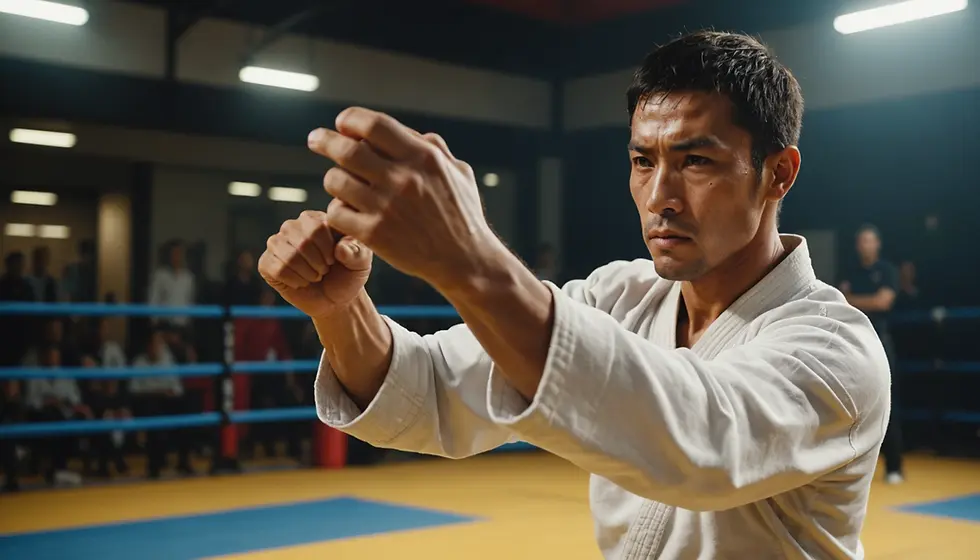Uncovering the Hidden Wisdom: Unlocking the Deeper Meaning of Bunkai and Kaiseki in Traditional Karate Practice
- Chris Clarry Shihan 8th Dan

- Feb 19
- 3 min read
When people think of traditional karate, they often see it as a sequence of movements, but there is so much more beneath that surface. Concepts like Bunkai and Kaiseki not only deepen the understanding of kata, but also provide karate practitioners with valuable insights into the martial art as a whole. This post will explore these concepts to reveal their crucial role in effective karate practice.

The Essence of Bunkai
Bunkai means understanding the hidden meanings and applications of techniques found in kata. Each movement in a kata is intentionally designed to convey several layers of meaning. For instance, a simple downward block may also serve as a counter to a strike or a setup for a throw.
In the early stages, students may view Bunkai as straightforward movements, focusing on self-defense techniques like escaping grabs or countering punches. A beginner might practice the first kata, Heian Shodan, executing basic blocks and strikes against imagined opponents. However, as they train, they begin to uncover more complex applications. For example, an advanced practitioner might apply the same movements to defend against multiple attackers, illustrating how dynamic and practical Bunkai can be.
The beauty of Bunkai lies in its adaptation. Each karateka, depending on their skill level and experience, interprets these moves in unique ways. This continual exploration of movement fosters a deeper relationship with the art and enhances mental engagement during practice.
The Role of Kaiseki in Kata Analysis
Kaiseki involves a detailed breakdown of kata to understand the principles and techniques behind each movement. It's more than just performing the kata correctly; understanding why certain techniques are executed in specific ways is key to mastering karate. For example, when analyzing the kata Gekisai Dai Ichi, practitioners may focus on the importance of timing and rhythm for executing effective strikes.
Karateka can improve their execution through careful analysis. Evaluating stance, body mechanics, and timing allows practitioners to weave efficiency into every technique. For instance, when practicing a reverse punch, understanding how to engage the hips and shoulders increases power significantly. Studies show that proper hip engagement can boost punch speed by 20%, emphasizing the practical advantages of Kaiseki.
When practitioners grasp the tactical implications of their movements through Kaiseki, they become more adaptable. They can apply techniques to different situations, enhancing their effectiveness in self-defense scenarios.
The Interconnection between Bunkai and Kaiseki
Bunkai and Kaiseki work hand in hand. While Bunkai illustrates the application of techniques, Kaiseki delves into their theoretical background. Together, they create a comprehensive understanding of kata as both a physical and philosophical discipline.
For example, when analyzing a kata like Tekki Shodan, a practitioner might identify Bunkai applications such as using a stance for both stability and evasion. Through Kaiseki, they reflect on the importance of lower body strength and grounding techniques, ensuring every movement is purposeful.
This reflective practice reveals that kata is not just a series of rehearsed motions, but a valuable resource filled with knowledge. As students progress, they find that their kata evolves alongside their skills, becoming a living, breathing aspect of their training.
The Journey of Practicing and Perfecting Kata
To master kata, practitioners should visualize their movements as flawlessly executed. This mental exercise helps in performing katas with greater precision. Imagine executing a kata like Bassai Dai with absolute clarity—each kick cuts sharply, blocks are solid, and every turn is smooth.
This visualization leads to more focused practice. When karateka work to translate their mental images into physical performance, the result is a continual refinement of their technique. As they repeatedly perfect their kata, they not only find their movements becoming smoother but also more powerful. This increase in efficiency is vital in high-pressure situations, where speed and precision can determine the outcome of a self-defense scenario.
The Distinction Between Different Observers
Onlookers may see kata as a simple display, but those who are experienced recognize its deeper significance. Unlike sport karate—which often prioritizes flashy presentations—traditional karate emphasizes practical applications and a profound understanding of movements.
For serious practitioners, it's essential to realize that the essence of karate lies not in showcasing athleticism but in developing real-world skills. By studying Bunkai and Kaiseki, karateka understand that every kata mirrors their growth and dedication to the art.
Embracing the Depth of Kata Practice
The important concepts of Bunkai and Kaiseki transform traditional karate from mere motion into a meaningful journey of understanding and mastery. By uncovering the hidden meanings within each kata, practitioners can fully realize their training's potential.
Engaging with these concepts enhances not only the effectiveness of techniques but also deepens appreciation for the art of karate. Every movement has significance, arming karateka with skills they can wield both on and off the mat.
In embracing Bunkai and Kaiseki, martial artists embark on a lifelong path of learning and growth, enriching their lives well beyond the dojo.







Comments